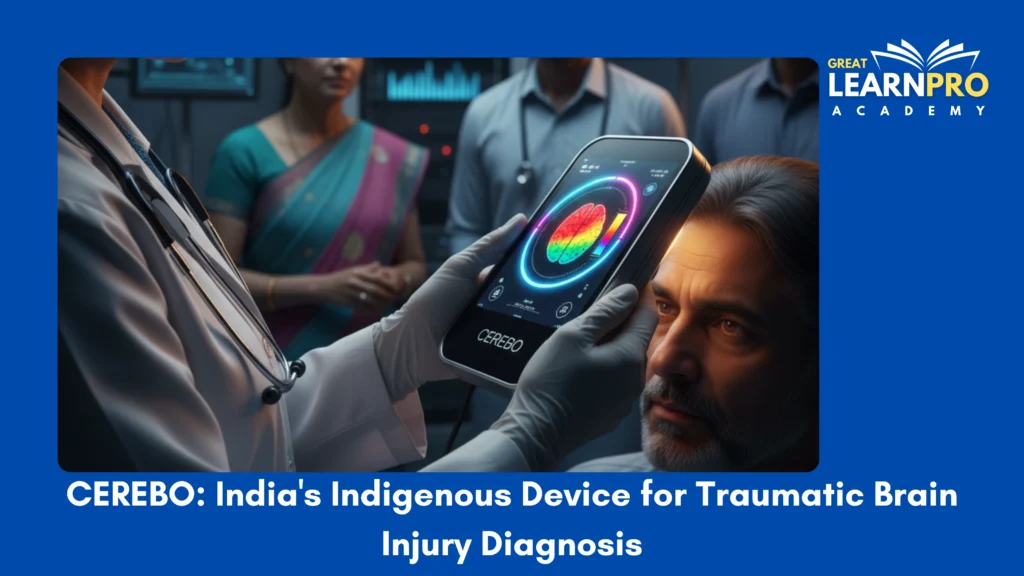
In a remarkable stride towards strengthening India’s medical technology ecosystem, scientists and doctors have developed CEREBO, an indigenous, hand-held brain diagnostic device designed to rapidly detect traumatic brain injuries (TBIs). Launched recently as part of the nation’s push for affordable and accessible healthcare solutions, this innovation is being hailed as a potential game-changer, particularly in rural and emergency settings where access to advanced neuroimaging facilities remains limited.
A Collaborative Effort
CEREBO has been developed through the collaborative efforts of the Indian Council of Medical Research (ICMR), AIIMS Bhopal, NIMHANS Bengaluru, and the start-up Bioscan Research. The tool embodies the spirit of collaboration between government research bodies, leading medical institutions, and Indian start-ups in creating cost-effective medical devices tailored for the country’s needs. Unlike high-end diagnostic machines imported at significant costs, CEREBO is fully indigenous, underscoring India’s growing capacity for medical innovation under the “Make in India” initiative.
How CEREBO Works
Traumatic brain injuries, often resulting from road accidents, falls, or assaults, are among the leading causes of mortality and disability in India. Conventional diagnosis typically requires CT scans or MRIs, both of which are expensive, time-consuming, and often unavailable in smaller hospitals. CEREBO addresses these challenges by using near-infrared spectroscopy combined with machine learning algorithms to detect intracranial bleeding and brain swelling within a matter of minutes.
The device is non-invasive, portable, and radiation-free, making it safe for infants, children, and even pregnant women. Its user-friendly design allows healthcare workers with basic training to operate it. The results are displayed in a color-coded format — green for normal, yellow for moderate concern, and red for high-risk cases — enabling quick triage and referrals.
Why It Matters for India
India reports more than a million traumatic brain injury cases annually, with road accidents being the most significant contributor. Many victims in rural and semi-urban areas lose their lives not because of the severity of the injury itself but due to delayed diagnosis and treatment. CEREBO seeks to bridge this gap by bringing diagnostic capability to the point of care. This is particularly crucial for India’s vast rural belt where advanced neuroimaging is either unavailable or requires long travel to tertiary hospitals. With CEREBO, even primary health centers or ambulance teams can perform an initial assessment, ensuring that critical patients receive timely interventions.
Broader Impact and Applications
Beyond its immediate application in emergency care, CEREBO is expected to transform how brain injuries are managed across diverse medical settings. Sports medicine specialists, military doctors, and disaster response teams could integrate the device into their practice, offering rapid screening in situations where every second counts. Its low cost compared to conventional imaging methods also positions it as an affordable option for developing nations facing similar healthcare challenges. Thus, CEREBO not only has domestic relevance but also carries export potential, aligning with India’s ambition to become a global hub for medical technology.
Challenges Ahead
Despite its promise, CEREBO’s journey is just beginning. Large-scale clinical validation is essential to establish its accuracy across varied populations and conditions. Training healthcare personnel in rural and semi-urban areas to use the device effectively will also be a key step. Furthermore, integration into existing public health infrastructure requires policy support, government procurement, and strong awareness campaigns.
Critics caution that while CEREBO can serve as a first-line diagnostic tool, it cannot fully replace CT or MRI scans, especially in complex cases requiring detailed imaging. Therefore, its role must be carefully defined as part of a tiered diagnostic approach, where it serves as a rapid screening device to identify high-risk patients.
A Step Towards Atmanirbhar Bharat in Healthcare
CEREBO’s development marks a significant milestone in India’s pursuit of self-reliance in healthcare innovation. The device embodies the goals of Atmanirbhar Bharat by reducing dependency on imported diagnostic technologies and empowering local solutions for pressing national challenges.
Moreover, its emphasis on affordability and accessibility echoes the government’s larger healthcare vision under schemes like Ayushman Bharat, which seeks to democratize medical services for the poorest and most vulnerable sections of society.
Conclusion
CEREBO is more than just a diagnostic tool; it is a symbol of India’s capacity to innovate for its own needs. By combining cutting-edge science with local realities, the device addresses a long-standing healthcare gap and promises to save countless lives. While challenges in scaling and integration remain, the successful deployment of CEREBO could well inspire a new wave of indigenous medical innovations. As India steps into an era where healthcare must be both high-tech and inclusive, CEREBO stands as a reminder that true progress lies in technology that not only advances science but also transforms lives.
Sources:
- https://www.tribuneindia.com/news/delhi/india-develops-indigenous-handheld-device-to-detect-traumatic-brain-injuries/?utm_
- https://theprint.in/health/icmr-pushes-for-made-in-india-handheld-that-can-detect-brain-bleeds-in-2-mins-all-about-cerebro/2723406/?utm_
- https://m.economictimes.com/news/international/us/chinas-brain-computer-interface-bci-trial-cuts-hydrocephalus-diagnosis-from-days-to-30-minutes/articleshow/123598531.cms?utm_
More Current affairs: https://learnproacademy.in/updates/
